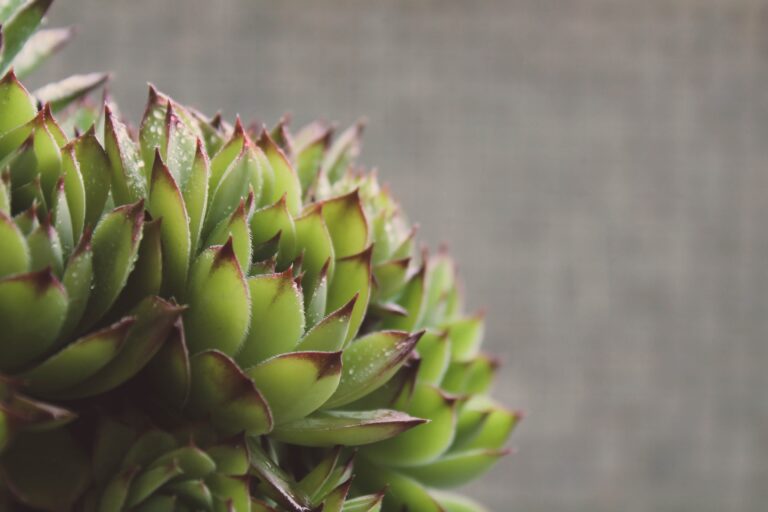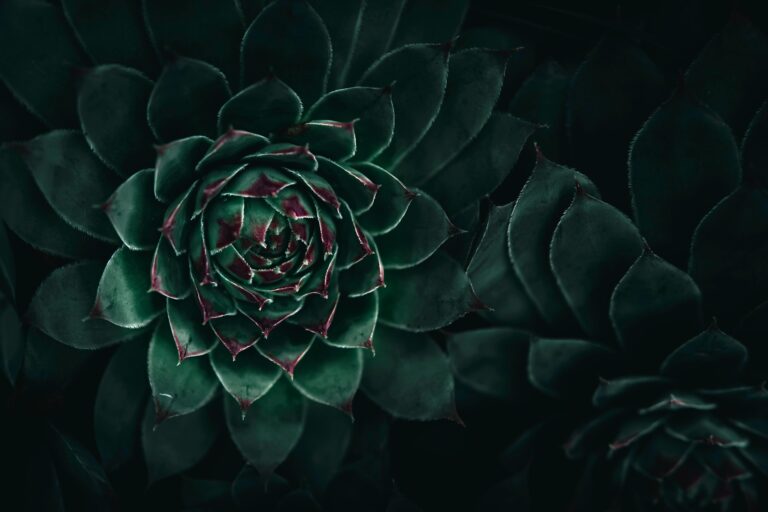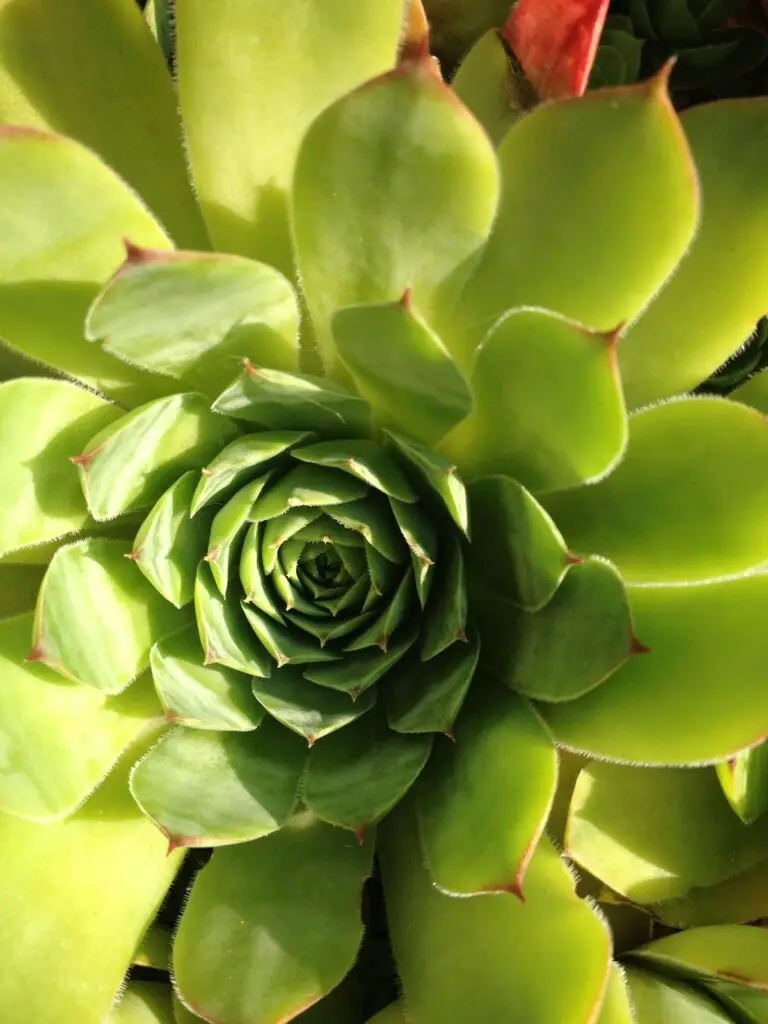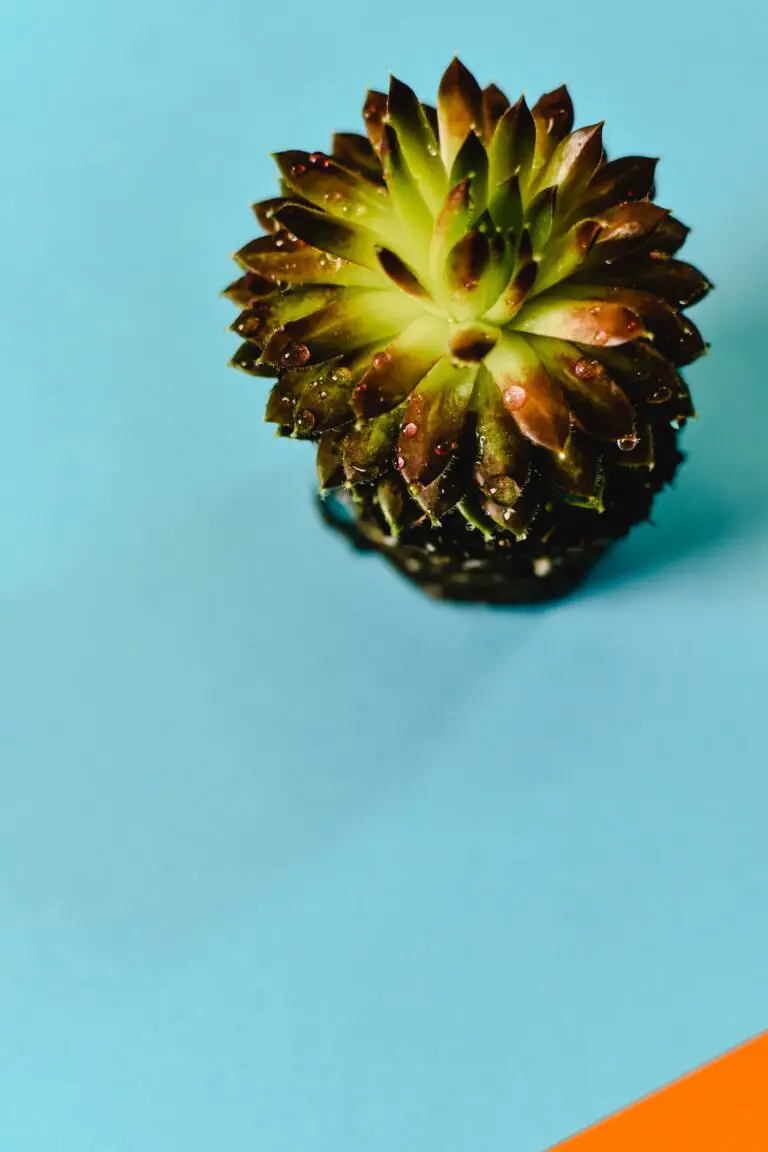Introduction to Houseleek Sempervivum Tectorum
Explore the enduring allure of the houseleek sempervivum tectorum, a hardy succulent beloved for its rosette patterns and resilience in diverse growing conditions. These charming plants are not just a feast for the eyes but a symbol of enduring life and adaptability. Commonly known as the common houseleek, hens-and-chicks, or even roof houseleek, this perennial has nestled into the nooks of culture, history, and modern gardening alike.
Imagine a plant so tenacious that it adorns rugged mountain crags and stone walls, embracing the extremes of our world with the same grace as it does in the cozy corners of your garden. The sempervivum tectorum doesn’t call for a green thumb; it flourishes with minimal care and seems to whisper a secret of survival to those who care to listen. Picture the cobblestone-lined streets of Southern Europe, where these succulents peek through roofs, an old-world touch to the architectural canvas—a sight both picturesque and purposeful, owing to an ancient Roman belief that these plants protect homes from lightning strikes.
For garden enthusiasts and novices alike, cultivating sempervivum tectorum can be a rewarding endeavor. Due to its low-maintenance nature and striking appearance, it’s a popular choice for rock gardens, containers, and green roofs. The joy of nurturing these succulents lies in their forgiving nature; whether faced with drought, poor soil, or harsh temperatures, the houseleek stands undaunted, showcasing its plump, verdant leaves year-round. If you aspire to add a touch of rugged beauty and resilience to your garden, the sempervivum tectorum presents itself as a trusty companion.
Let’s dive into the practical aspect of cultivating these robust beauties. While they are famously easy to care for, there are certain tips and tricks that can help you maximize their potential. For those of you looking to delve deeper into the world of sempervivum tectorum, here’s a comprehensive guide that walks you through everything from propagation to common pests.
And to get you started on your houseleek journey, why not take a look at this informative video on the propagation and planting of sempervivum? It’s a visual feast that offers valuable insights into separating and nurturing your own hens and chicks.
Origins and History
Delve into the rich history of the sempervivum species, discovering its ancient use and symbolism in various cultures. Plucked straight from the annals of time, the cultural tapestry woven around these enduring succulents is as captivating as the plants themselves. It’s no secret that our green-thumbed ancestors were enamored by the resilience of Houseleek Sempervivum Tectorum, a trait that made it a staple in folk traditions and myths.
Imagine strolling through the cobbled streets of ancient Europe, where houseleeks grew abundantly on thatched roofs, believed by many to ward off lightning and fire. It was a living, breathing charm against the whims of nature, merging practicality with a touch of the mystical. Or picture the scene in medieval gardens, where these robust rosettes were more than just ornamental—they were signs of protection and prosperity, echoing the sentiments of an era that held nature in high regard.
Peruse historical texts, and you’ll stumble upon houseleeks nestled in the pages, under their classical name ‘Sempervivum,’ derived from Latin, meaning ‘live forever.’ The name itself reflects the storied past and tenacity of these plants, which have not only survived but thrived through centuries of horticultural trends and changing climates.
From the rocky crags of their mountain origins to the modern minimalist’s windowsill, houseleeks have journeyed across time, a testament to their adaptability and charm. This section of botanical history is not just about plants; it’s a reflection of human civilization—how we connect with nature and the enduring legacies we cherish and cultivate in our gardens.
In every fleshy leaf and every symmetrical rosette lies a story, a slice of history that continues to evolve even in today’s technologically driven world. The sempervivum’s saga is a mosaic of mythology, utility, and beauty that endures, inspiring gardeners and nature lovers alike.

Botanical Profile: Understanding the Species
Embark on a botanical journey with us as we delve into the green, textured world of houseleek sempervivum tectorum, a resilient succulent that has carved its niche in gardens around the globe. With an allure that is both rugged and charming, this succulent species is a treasure trove of unique characteristics waiting to be explored.

These tough little plants forge their way into our landscapes and hearts, not just with their beauty but with their sheer will to thrive in various conditions. Think about it: from rocky crevices to that little terracotta pot on your balcony, the sempervivum tectorum stands unfazed by the extremes, radiating life and soothing greenery.
What Sets the Houseleek Apart?
But what really makes houseleek sempervivum tectorum stand out in the succulent community? Is it the rosettes that fan out like a deck of thick, fleshy cards? Or the way they bloom, sending up a tower of flowers as if to claim their sovereignty in your garden? The answer may lie in their resilience; legend has it that these succulents were once used as a protective charm against lightning!
However, don’t take our word for it; discover more about their care and cultivation to see how you can help these little guys prosper. Meanwhile, those searching for gardening inspiration can explore a world of other succulent types and what makes each of them distinct.
Whether you’re an experienced gardener or just starting, learning about the houseleek sempervivum tectorum is like unearthing a living piece of folklore that’s as full of life as the stories it inspires. It’s not just another plant; it’s a legacy of endurance that teaches us the beauty of growing against the odds. So, when you next gaze at your garden embellished with these living gems, remember the heritage they carry and the simple yet profound joy they add to our lives.
Perfect Planting: Getting Your Sempervivum Started
Imagine a low-maintenance, resilient splash of greenery that can elevate the charm of your garden while asking so little in return. Yes, we’re talking about the delightful Houseleek, Sempervivum tectorum. But, to unlock its full potential in your garden, it’s crucial to get a few things right from day one!
Let’s dive into the essentials of planting these hardy rosettes. First up: the foundation of any thriving plant – the soil. For Sempervivum, think porous and gritty. You want a soil mix that practically mimics the rocky crevices of its natural mountainous homes – a well-draining mix that prevents any water-logging risks, crucial for these drought-tolerant champions.

Moving on to location, location, location! Sunlight is a non-negotiable for your Sempervivum. These plants adore basking in at least six hours of sunlight daily. Think of a sun-kissed spot in your garden where these beauties can soak up those rays. But they’re not just sun-worshippers; they can tolerate a bit of shade too. This flexibility makes them ideal for spots that get a mix of light throughout the day.
When it’s time to nestle them into the ground, remember – shallow is the way to go. A planting depth just enough to anchor the roots and a little tucking in with the soil is all that’s needed. They’re not fans of being buried deep – it’s about giving them enough room to spread out and showcase their rosette magic.
For more tips and insights on creating the perfect home for your succulent companions, make sure to read our guide on succulent soil mixes. It’s your roadmap to ensuring a thriving, vibrant collection of these forgiving plants.
As you follow these planting steps, you’re laying the groundwork for a sempervivum haven. With a start like this, you can almost see the glorious spread of textured greens and warm hints of color, can’t you? So, let’s get those garden gloves on and transform those visions into lush reality!
Essential Tips for Houseleek Care
Envision a garden speckled with the rugged beauty of Houseleek Sempervivum Tectorum, a low-maintenance charmer that spruces up any outdoor space. Getting these succulent wonders to flourish is simple if you’ve got the right tools and tips at your disposal. Let’s dive into a gardener’s playbook to unlock the secrets of nurturing houseleeks successfully.
Watering Wisdom for Sempervivums
When it comes to quenching your houseleek’s thirst, it’s all about balance. Imagine a tightrope walker—your watering routine needs that level of precision! Overwatering is the arch-nemesis of sempervivums, so ensure the soil goes slightly dry between watering sessions. A pro tip: mimic the natural alpine conditions these plants adore by opting for a soak-and-dry method. It’s like giving your houseleeks a taste of their mountainous home!
Sunlight: A Love Affair with the Rays
Sempervivums and sunlight are in a committed relationship, and they’re not shy about it. These plants are solar-powered beauties that demand a spot where the sun generously bathes them in golden light. Aim for six hours of direct sunlight daily, and watch them bask and grow in the warmth. Remember, they’re like sunbathers lounging by the poolside—they can never have too much of those glorious rays!
Maintenance Practices: The Sempervivum Routine
Picture yourself as a sempervivum stylist—trimming dead leaves, managing offsets, and crafting the perfect rosette. The occasional grooming session can do wonders, encouraging healthy growth and preventing disease. Also, don’t forget the power of a well-draining soil mix, along with a pot that says ‘breathability’ with its drainage holes. It’s like setting the stage for your houseleeks to perform their best.
For a more visual aid and a peek into the practical side of sempervivum care, check out this helpful video:
Embrace these essential tips, and you’ll be the proud caretaker of a sempervivum sanctuary. With minimal effort, your garden can become a showcase of their enduring charm, proving that sometimes, the most enchanting elements of nature are the ones that thrive with a touch of neglect and a dash of love.
Propagation Possibilities
Uncover the secrets of propagating houseleek sempervivum tectorum to multiply your collection or share with fellow gardeners. The joy of seeing these resilient succulents take root and flourish is akin to a gardener’s treasure hunt—with patience and a dash of know-how, you’ll be rewarded with a bountiful trove of these charming rosettes.
Sempervivum tectorum, with its nickname derived from the Latin ‘always alive’, is a testament to the plant’s hardy nature. Picture this: after a friend’s birthday, you gift them a delightful cluster of houseleek cuttings you’ve propagated yourself. They’re not just receiving a plant, but a growing piece of your garden, and the joy multiplies.

Propagation of these succulents is primarily done through offsets, affectionately known as ‘chicks’. These little clones of the parent plant, sprouting eagerly at their sides, are eager to strike out on their own. With the right touch, you guide these chicks to become independent, robust plants. It’s as simple as gently detaching them and planting them in their own cozy nook of soil, where they can spread their roots.
Getting Down to the Nitty-Gritty
What’s the best time for this botanical adventure? Spring and summer, when the plants are in their growth spurt and more likely to root successfully, eagerly reaching into the soil like children grasping for sweets. The process is straightforward—pluck a chick, let it callous over for a day or two to prevent rot, and then nestle it into a mix of well-draining soil and sand. Water it sparingly, as though you’re teasing it with just enough to drink, and watch as it anchors itself firmly and begins its growth journey.
Though they’re tough as nails, these plants appreciate a little TLC during the propagation process. Picture them basking in a spot with bright, indirect sunlight, shielded from the harsh midday rays that can be a bit too intense even for these sun worshipers. A touch of water here and there, never too much to dampen their spirits, and before you know it, the chicks will have transformed into a thriving congregation of greenery.
So, as you plot your garden’s next expansion, remember the propagation possibilities that sempervivum tectorum presents. Each tiny chick is a future cluster, a verdant mosaic on your garden canvas, a living connection between friends and family. It’s a sustainable cycle of gardening that not only enriches your outdoor space but weaves a narrative of growth and generosity with every new rosette.
Common Challenges and Solutions
Growing Houseleek Sempervivum tectorum can sometimes feel like a high-stakes gardening adventure. These hardy succulents bring a dash of resilience to your green space, but even the toughest plants have their kryptonite. Let’s take a deep dive into the issues that could be bugging your beloved houseleeks and turn those problems into past tense!
Warding Off Pesky Pests
Say you’re admiring your collection of sempervivums, each a rosette of perfection, when you spot aphids conspiring on the underside of a leaf. Fear not, for the solution is straightforward! A gentle blast of water dislodges these invaders, and introducing natural predators like ladybugs keeps the aphids from plotting a return. If aphids insist on a comeback tour, a mild soap solution is your next line of defense – it’s like sending a polite yet firm ‘keep out’ message.
Confronting Environmental Stress
Imagine a sempervivum suffering from the wintertime blues. Frost isn’t just a challenge for humans trying to shovel driveways; it can stress even our frost-tolerant friends. The trick here is to ensure good drainage in your pots or garden beds. Standing water around the roots during a cold snap is a recipe for rot. Tuck them in with a mulch blanket, and your semps will snooze through the cold, unperturbed.
But what about the flip side – the sweltering summer sun? Sempervivums love light, but too much direct sun can scorch their tips as surely as it can sunburn a new beachgoer. The key to keeping your sempervivums from frying? Provide light shade during the peak hours of sunshine. Think of it as putting a parasol over your plants – they get to enjoy the warm weather without the risk of a burn.
Thwarting Thirst Issues

Overwatering is akin to serving your plants a beverage in a bottomless cup—it’s just too much of a good thing. Sempervivums prefer a ‘sip, not a gulp’ approach to hydration. Water them deeply, but infrequently, and always check that the soil is dry before offering another drink. It’s like teaching your plants the art of drinking responsibly—hydrate but don’t drown.
If you’re enjoying these verdant vibes but find your sempervivums are still not thriving, it might be time to look at the root of the issue—literally. Poor soil can leave sempervivums pining for nutrients. The fix? A well-draining soil mix that caters to their need for a lean diet, much like an elite athlete’s carefully planned nutrition plan. Every now and then, a little low-nitrogen fertilizer can work wonders, just like a protein shake for your plants.
By understanding the common challenges faced by Houseleek Sempervivum tectorum cultivators and deploying these practical solutions, you can ensure your garden remains a stronghold of horticultural happiness. Remember, every challenge is an opportunity to grow—not just for your plants but for you as a gardener.
Landscape and Design Uses
The charm of houseleek sempervivum tectorum goes beyond its tenacity and resilience; it’s a design marvel in the plant world. Let’s dig into the earthy artistry of incorporating these succulent gems into your garden tableau.
Rockeries: Stone and Succulent Symphony
Imagine a natural amphitheater where each stone is strategically in harmony with vibrant clusters of sempervivum. Rockeries emulate the mountainous habitats these stoic succulents thrive in, creating a rugged yet enchanting mini landscape in your garden. Picture weathered rocks of varied shapes bedecked with rosettes in shades from jade to ruby, bathed in sunlight – a testament to the sheer tenacity and beauty of these wonders.
Green Roofs: Elevate Your Ecology
Why not take your eco-friendly ethos to new heights? Green roofs festooned with sempervivum not only insulate and absorb rainwater but offer a verdant vista in often-overlooked spaces. They epitomize sustainable beauty and transform rooftops into buzzing biodiversity hotspots. It’s about cultivating a living tapestry that’s as beneficial for your home as it is beguiling to behold.
Container Gardens: Versatile Vignettes
Container gardens are vibrant vignettes showcasing the versatility of sempervivum. Interspersing these hardy succulents amongst other potted plants adds texture and form, creating a captivating visual narrative. From rustic terracotta pots to modern minimalist containers, sempervivum shines, making it the perfect protagonist in the story of your garden’s design.
Integrating houseleek sempervivum tectorum into your garden is not just about planting a succulent; it’s about painting with a palette of texture, color, and resilience. These design ideas are merely a starting point; the potential is as boundless as your creativity. Embrace the sempervivum’s enduring spirit and watch as it breathes new life into your garden narrative.
The Role of Sempervivum in Sustainable Gardening
Imagine a plant that’s not only a visual delight in your garden but also an embodiment of sustainability. Yes, we’re talking about the resilient ‘houseleek,’ or Sempervivum tectorum, a true gardener’s ally in the green movement. Its rosettes of fleshy leaves add a textured charm while playing an integral role in eco-friendly gardening practices.
Now, picture a community of these hardy plants coexisting in your garden space. Each rosette of Sempervivum tectorum works silently, contributing to a biodiverse ecosystem. These living sculptures need minimal care, thriving on rainwater and the occasional sunshine, thus reducing the need for artificial watering and chemical fertilizers. It’s a low-maintenance dream turned reality for sustainable landscape enthusiasts.

In an era where urbanization often strips away natural habitats, introducing Sempervivum tectorum can be a gesture of reconciliation with nature. By cultivating houseleeks, you’re doing more than just decorating; you’re creating micro-habitats for insects and providing a green respite in a concrete world. It’s a simple, yet profound way to foster biodiversity right in your backyard.
Moreover, Sempervivum tectorum sets an exemplar for sustainable practices by promoting soil stability with its extensive root system. This not only prevents soil erosion but also maintains the health of the garden bed, ensuring a fertile ground for other plant species to flourish. A domino effect is set in motion where each element in your garden sustains the next, reflecting a miniature ecosystem at work.
Embracing Sempervivum tectorum in your garden is akin to adopting an eco-friendly ethos. Its persistent nature, requiring minimal intervention, echoes the principles of sustainability. As you commune with these emerald wonders, remember that the beauty of houseleeks extends far beyond their aesthetic appeal – it lies in their silent contribution to a healthier planet.
Frequently Asked Questions
Got a burning question about your alluring alpine gem, the Houseleek Sempervivum Tectorum? You’re not alone! Friends, garden enthusiasts, and curious minds alike have inquired about the best ways to nurture these hardy charmers, and we’re here to dig in with some expert answers. Let’s unlock the secrets to a thriving houseleek haven!
What’s the Best Way to Plant and Propagate My Houseleek?
Imagine you’re a tiny chick nestled under the wing of a hen—that’s how these plants like to grow! A well-drained soil with gritty sand or perlite will mimic their natural rocky habitats. For propagation, gently pull a chick, let the end callous for a day, and then nestle it onto the soil. Picture this: clusters of hens and chicks painting a textured, living tapestry in your garden, year after year!
How Often Should I Water My Sempervivums?
Picture a camel in miniature plant form—that’s your houseleek, storing water in its fleshy leaves. Water it too much, and it’ll pout with rot. Too little, and it might get thirsty. Aim for a golden mean, letting it dry out between waterings. It’s like giving your plant a sip from a pint-sized watering can after a sunny day at the beach—just enough to quench its thirst.
Does Sempervivum Tectorum Need a Special Type of Fertilizer?
These stoic succulents are the ascetics of the plant world—they thrive on neglect! Skip the heavy meals; a light feeding of half-strength succulent fertilizer in the growing season will do. It’s like snacking on a granola bar instead of a four-course meal – simple, yet sufficient.
Can My Houseleek Survive Frosty Weather?
Armored in natural antifreeze, houseleeks boast a resilience that lets them scoff at the cold. Envision these green soldiers standing firm as the winter frost rolls in, unyielding and evergreen. As long as they’re not waterlogged, they’re ready for Jack Frost’s chilliest challenges.
Are Sempervivums Susceptible to Pests and Diseases?
Houseleeks may be tough, but they aren’t invincible. Overwatering can invite fungal miscreants, while mealybugs and spider mites might crash the party. Maintain vigilance with a good inspecting routine—like a garden detective—and you’ll keep these plants as secure as a fortified castle.
Feeling prepped to cultivate your own sempervivum sanctuary? Check out this hands-on video for more tips on nurturing your houseleek:

